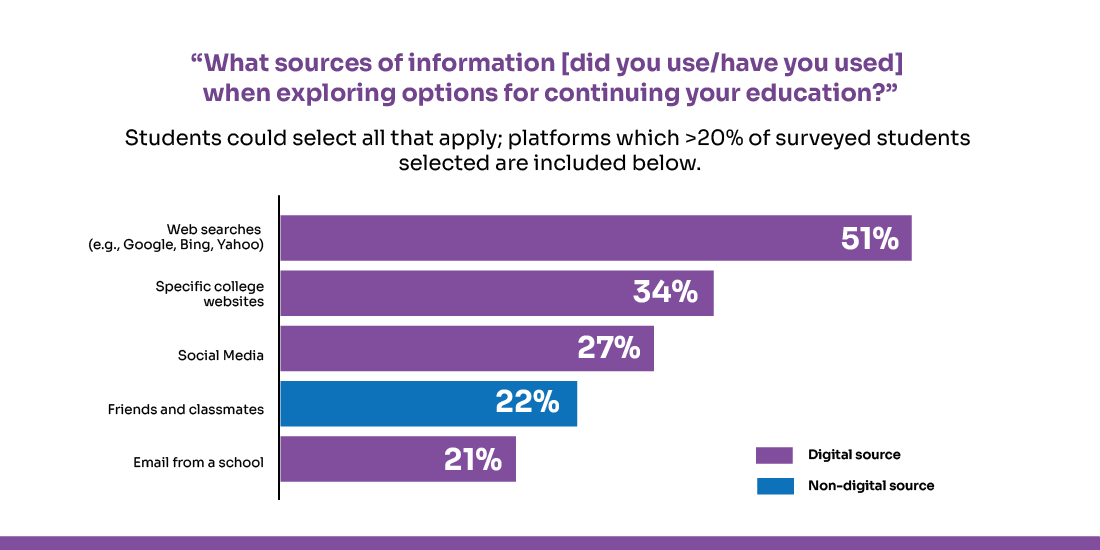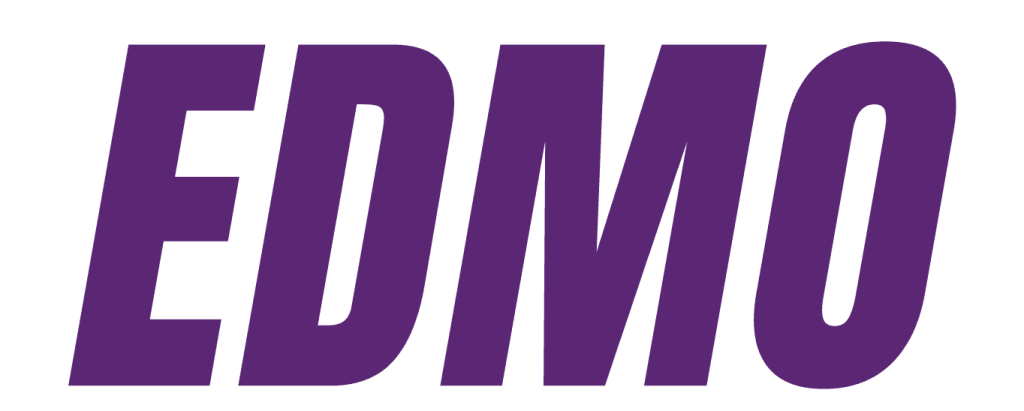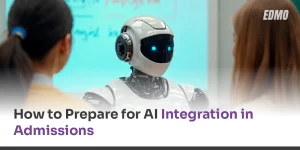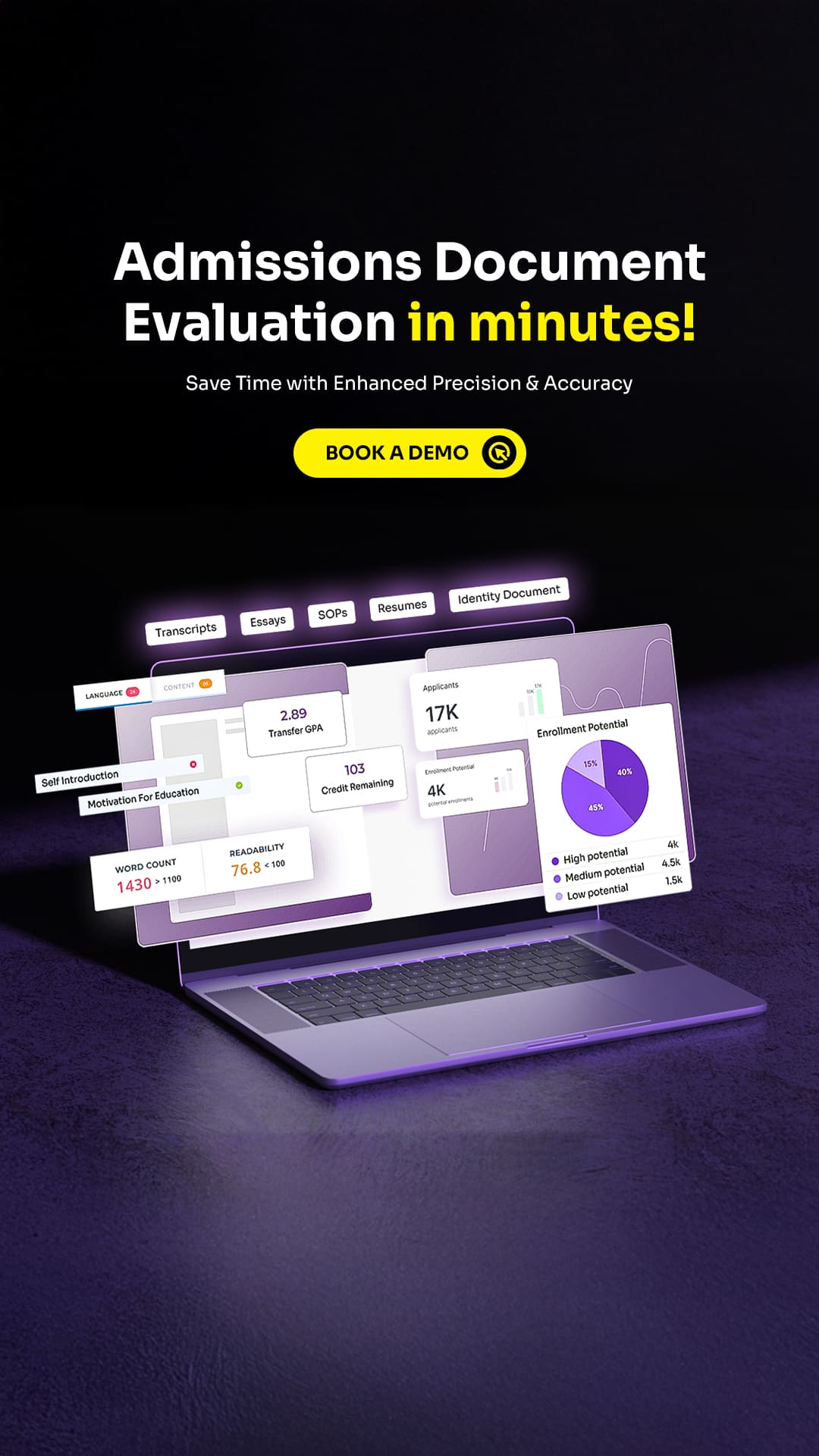Table Of Contents
- 1Introduction
- 2Understanding Marketing in Higher Education
- 3Why is it Important to Prioritize Marketing for Higher Education Institutions?
- 4Essential Questions to Build an Effective Higher Education Marketing Plan
- 5Leading Higher Education Marketing Strategies for 2025 and Beyond
- 6Best Platforms to Market Your Educational Offerings
- 719 Key Higher Education Marketing Trends with Examples
- 8Conclusion
Introduction
Marketing plays a crucial role in helping higher education institutions attract students, engage faculty, and strengthen relationships with stakeholders. In a 2025 survey, 65% of institutions reported actively using emerging technologies like AI in their marketing and enrollment efforts, up from 40% in 2024, highlighting the growing importance of tech-driven strategies. By adopting innovative marketing approaches, universities can stay competitive, enhance student experiences, and drive long-term growth.
Understanding Marketing in Higher Education
Higher education marketing involves the strategies and efforts colleges and universities use to promote their institution, academic programs, and overall brand to prospective students, parents, and other key stakeholders.
Effective higher education marketing not only highlights the unique features of a college or university—such as courses, faculty expertise, campus facilities, and career opportunities—but also builds a strong and positive reputation in a competitive education market. It combines traditional methods like brochures and campus events with digital strategies such as social media, email campaigns, and search engine marketing to reach and engage the right audience.
Why is it Important to Prioritize Marketing for Higher Education Institutions?
In today’s competitive academic environment, universities and colleges need to stand out, attract more students, and build diverse communities. Prioritizing marketing helps them highlight their unique programs, clearly communicate their value, and connect with important audiences that influence their growth and success.
Engaging and Attracting Students
Students are the core focus of higher education marketing. Whether full-time on-campus or part-time balancing work and studies, their tuition contributes significantly to a university’s revenue. Effective marketing allows institutions to highlight academic programs, campus experiences, and career opportunities, helping students find a university that fits their goals. In fact, a 2025 survey shows that 95% of prospective students research colleges online before deciding.
Informing and Influencing Parents
Parents play a key role in deciding where their children study, often evaluating factors like academic reputation, cost, and safety. Strategic marketing gives them the information needed to make informed choices. Moreover, many parents pursue continuing education or online programs themselves, making them an important audience. Today, search engines, college websites, and social media are far more influential than traditional marketing methods.

Source: EAB
Attracting and Retaining Faculty
An institution’s growth and reputation depend on the quality of its faculty. Professors, researchers, administrators, and coaches all contribute to academic excellence. A strong marketing strategy helps universities highlight their culture, research facilities, and academic achievements—key factors that attract and retain top educators and professionals.
Building Donor Relationships
Donors are crucial for supporting scholarships, campus development, and infrastructure projects. Marketing helps showcase the impact of their contributions, highlight success stories, and emphasize the long-term value of giving. Through compelling storytelling and engagement campaigns, institutions can build trust and encourage ongoing support. In FY 2024, charitable donations to U.S. colleges increased by 3%, reaching $61.5 billion, reflecting sustained donor confidence in higher education.
Essential Questions to Build an Effective Higher Education Marketing Plan
Once you have a good understanding of current higher education trends, the next step is to design a strong marketing plan for your college or university. Collaborate with different departments, gather insights from faculty and staff, and review your website to ensure that all messaging and branding align with your overall marketing goals.
Here are some key questions to guide your planning process:
Who Is Our Target Audience?
Identify the main groups you want to reach—prospective students, parents, faculty, alumni, or donors. Define audience personas to understand their motivations, preferences, and decision-making factors.
What Are Our Key Performance Indicators (KPIs)?
Determine how you’ll measure marketing success. This could include engagement metrics such as website traffic, social media interactions, lead conversions, or enrollment inquiries.
What Is the Core Message of Our Marketing Plan?
Clarify the central message or value proposition you want every prospective student or stakeholder to know about your institution. This should reflect your mission, academic strengths, and unique opportunities.
How Do We Stand Out from Other Institutions?
Highlight what makes your college or university different—such as innovative programs, global partnerships, strong alumni networks, or personalized learning experiences.
Leading Higher Education Marketing Strategies for 2025 and Beyond
Strong marketing is essential for universities to draw students, engage faculty, and strengthen stakeholder trust. Here’s a look at the key strategies institutions should focus on today.
Optimize for AI Searchers
Generative AI is changing how prospective students search for information. Zero-click searches — where AI provides direct answers without needing to visit a website — are becoming the majority of queries.
Key Steps:
- Create structured, conversational content designed for AI retrieval.
- Focus on FAQs, clear definitions, and outcome-driven data.
- Diversify traffic sources using SEO, paid campaigns, and strong digital experiences.
This shift goes beyond traditional SEO — it’s now a core part of higher education marketing strategy.
AI-Supported, Human-Centered Creativity
AI is now embedded in higher education marketing workflows, assisting in generating campaign ideas, personalizing messaging, and predicting outcomes. However, the real competitive edge comes when AI enhances, not replaces, human creativity.
Approach:
- Use AI to accelerate production: ideation, headlines, personalization cues.
- Keep teams focused on authentic, human-driven storytelling.
- Build a culture that values both technological fluency and creative intuition.
In fact, 69% of higher education institutions reported improved efficiency in marketing and enrollment processes after implementing AI-driven technologies. Tools like EDMO’s Conversation Intelligence further help universities analyze interactions, optimize communications, and gain actionable insights to engage students more effectively. By combining AI with human creativity, institutions can elevate both marketing outcomes and student experience.
Building Institutional Trust
With growing doubts about the value of higher education, families are asking whether the investment is worth it and what outcomes they can expect. As enrollment numbers face potential declines, institutions need to focus on clearly demonstrating their value.
Approach:
- Spotlight outcomes: Share data on job placement, graduate earnings, and alumni success stories.
- Showcase testimonials: Humanize ROI with student voices and career impact narratives.
- Reinforce program value: Use research and rankings to strengthen credibility.
Notably, 92% of students are more interested in institutions that use video in their marketing.
Cross-Lifecycle Marketing
Higher education marketing strategy can no longer stop at the inquiry. The student journey is long, nonlinear, and filled with digital touchpoints that extend well past enrollment.
Approach:
- Use remarketing to reinforce brand and program value throughout the funnel.
- Engage students across the lifecycle—from inquiry to enrollment to retention and even alumni relations.
- Tailor content to each stage, aligning messages to nurture confidence, reduce uncertainty, and strengthen connection.
Research shows that 51% of students prefer receiving communication from institutions via email.
Bot Mitigation
Bot traffic is a growing challenge for institutions. Automated hits can inflate website visits, distort engagement metrics, and ultimately mislead decision-makers about which campaigns are working.
Best Practices:
- Set up filters in Google Analytics to remove known bot traffic.
- Partner with bot mitigation providers to extend protections to include inquiry and application forms, safeguarding against fraudulent submissions.
- Regularly audit campaign data to ensure accuracy.
Globally, over $100 billion in advertising is lost each year due to invalid bot activity.
Use a CMS Built for Higher Education
Implementing a quality web content management system (CMS) designed specifically for colleges and universities can eliminate many of your school’s digital marketing challenges.
Benefits:
- Manage content efficiently and effectively.
- Allow non-technical users to organize, create, and manage digital content without complicated coding.
- Maintain consistent messaging and branding.
- Improve search rankings with easy updates to page titles, descriptions, and meta tags.
Engage Current Students
Peer-to-peer communication is highly influential. Students can share authentic experiences through blogs, social media takeovers, and testimonials.
Tips:
- Encourage students to post genuine campus experiences.
- Avoid staged content; authenticity resonates best.
Example: Texas Christian University shares student study-abroad adventures via #tcustudyabroad on Instagram.
Incorporate Email Marketing with a CMS
Email marketing for higher education is a great tool. But, while blanket emails get deleted; personalized, targeted emails get noticed by prospective students.
Tips:
- Use graphics and multimedia to make emails engaging.
- Segment audiences for targeted messaging.
In fact, 69% of education marketers report that email delivers a good to excellent ROI, outperforming social media (55%), display ads (19%), and even SEO (46%).
Leverage Video Content
Video content is critical for student recruitment and engagement.
Strategies:
- Embed videos on websites and social media to showcase campus life.
- Livestream events such as lectures, sports, and student activities.
Example: The University of North Carolina School of the Arts highlights student performances to give prospective students a glimpse of the programs.
Keep Track of Your Brand
Online marketing in higher education is getting more important day by day. What is your school’s digital image? What do students and fans share? When you have something positive to share, social media is a great way to market your college or university!
Tips:
- Use the power of social media in higher education.
- What social media platforms are the best marketing strategy for higher education? All of them.
- Snapchat and Instagram are used most frequently by students on a daily basis, while parents continue to scroll through Facebook for their social media fix.
Personalize at Scale
Marketing for universities should include personalized experiences. The 2021 E-Expectations Trend Report shows that students have grown up in an era of curated content and personalized experiences. They expect no less from your institution.
Approach:
- Deliver personalized content for web pages, communications, videos, and tools such as net cost calculators.
- Adapt to the evolving needs of learners across all stages of life.
According to EAB’s 2024 Personalization Survey, 93% of students said receiving a personalized message from a college would make them more likely to explore that school.
Include SEO and Conversion in Your Program Pages
SEO is the answer when asking how to market a university. The 2021 E-Expectations Trend Report illustrates that 6 out of 10 students search for academic programs, which means many will arrive at web pages for your programs instead of coming through your home page.
Strategies:
- Ensure program pages rank higher than your competitors on search engines.
- Include clear calls to action, so you convert those visitors to inquiries.
Best Platforms to Market Your Educational Offerings
Reaching prospective students effectively requires using multiple communication channels. Text messages can be particularly effective before an application deadline and after an application is submitted, as most students are open to receiving updates this way.
- Social Media – Twitter, Facebook, LinkedIn, Instagram, Snapchat. Social media is especially useful for students who want to learn more about a school.
- Email – Personalized, targeted emails remain an effective tool to engage and inform students.
- Direct Mail – Physical mail can complement digital campaigns and provide a tangible connection.
- Phone Calls – Direct conversations help answer questions and guide students through the enrollment process.
- Website – Your website is the central hub for information, applications, and program details.
19 Key Higher Education Marketing Trends with Examples
Students and prospective students today have constantly evolving expectations, making it essential for universities and colleges to stay updated with the latest marketing trends. Here are 19 marketing trends that are delivering impressive results in higher education.
Short-Form Video Content Drives Engagement
Mobile usage has fueled the popularity of short-form video content. Universities can capture students’ attention with brief, digestible videos showcasing campus life.
Example: The University of Michigan creates short videos highlighting daily campus life, classes, and student activities. They also repurpose existing content into short clips for better engagement.
Long-Form Video on YouTube for Brand Building
YouTube remains a key platform for reaching students. Long-form videos can showcase events, campus updates, and faculty or alumni achievements.
Example: The University of Houston features live-streamed events, departmental updates, and renowned alumni interviews, boosting visibility and credibility.
Virtual and Augmented Reality Campus Tours
AR and VR technology allow students to explore campuses remotely, saving time and costs associated with in-person visits.
Example: UC Berkeley offers 360-degree virtual tours using platforms like YouVisit. Over 22,000 visitors have taken general tours, while 3,000 explored specific locations like residence halls.
Authentic Storytelling to Engage Gen Z
Gen Z values authenticity. Sharing real student experiences helps prospective students connect emotionally with the university.
Example: University for the Creative Arts (UCA) features students telling their own stories about studio spaces and campus life, creating an immersive and relatable experience.
Diversity, Equity, and Inclusion (DEI) Messaging
Promoting DEI shows students that every background is valued. Institutions highlight diversity, equitable opportunities, and inclusive campus environments.
Example: The University of Michigan emphasizes DEI through events like the fall Diversity Summit and Martin Luther King Jr. symposium.
Google Ads with Intent-Driven Formats
Using ad intent, universities can display relevant ads that match prospective students’ search behaviors, improving engagement.
Example: Seattle University applies ad intents to MBA program pages, converting existing content into clickable links tailored to users’ search queries.
TikTok for Student Engagement
TikTok’s popularity among young audiences makes it a strong channel for universities to promote events and programs using trendy, student-generated content.
Example: Lancaster University collaborated with students to create TikTok videos for online open days, generating over 10M impressions and 9M engagements.
Geotargeting and Geofencing for Precision Outreach
Location-based marketing has become an increasingly effective strategy for higher education institutions to connect with potential students in specific regions or during relevant events.
Example: Regis University implemented a geofencing campaign targeting 12 college fairs and 16 feeder schools. When students attended these events, they received ads about Regis University’s programs. This strategy led to a 13% increase in first-year applications compared to the previous three-year average.
Influencer Marketing to Engage and Inspire Gen Z
Influencer marketing has emerged as one of the most authentic and relatable ways to reach Gen Z students. Unlike traditional advertising, influencer-led campaigns use trusted student voices to showcase genuine campus experiences.
Example: Mia Aston, a student influencer at New York University (NYU), has built a following of over 44,000 subscribers on YouTube. Through her college vlogs, she shares daily campus life, fashion choices, and academic experiences.
Alumni Engagement and Ambassador Programs
Alumni play a crucial role in promoting a university’s reputation and culture. Engaging them as ambassadors strengthens connections between past and prospective students and adds credibility to recruitment campaigns.
Example: Utah Tech University’s Alumni Ambassadors Program (UTAA) encourages alumni to maintain long-term relationships with their alma mater.
Personalized Experiences for Prospective Students
Gen Z students prefer personalized and interactive communication over generic outreach. Studies show that 1 in 5 Gen Z recipients engage with personalized brand emails, which is 13% higher than average consumers.
Example: The University of South Dakota creates personalized acceptance videos that mention each student’s name, achievements, and intended major.
User-Centric and Technical SEO
Universities are optimizing websites for search engines with a focus on content relevance, speed, and usability.
Example: University of Hawaii ranks for program-specific searches like “Masters in Psychology Hawaii” using keyword optimization, structured data, and quality content.
Podcasts for Engagement and Brand Storytelling
Podcasts have emerged as a powerful tool for higher education institutions to connect with audiences through authentic storytelling.
Example: The University of Leeds runs the “Forever Leeds” podcast, where alumni share personal journeys and achievements. This not only strengthens alumni engagement but also reinforces the university’s brand identity and values.
Student-Centric Blogging
Blogging remains a key content strategy for universities to attract, inform, and inspire prospective students. Student-written blogs provide first-hand experiences, academic insights, and cultural perspectives—helping applicants relate to real campus life.
Example: The University of London features a collection of student blogs where learners discuss their study experiences, adjusting to campus life, and career goals.
AI-Enhanced Conversational Marketing
Artificial Intelligence (AI) chatbots have transformed how universities communicate with students. These bots provide instant responses to queries about admissions, scholarships, and campus facilities—offering 24/7 support that improves user experience.
Example: UC Berkeley uses AI-powered chatbots to assist students with career services, admissions, and financial aid inquiries.
Google Display Ads for Wider Reach
Google Display Ads allow universities to extend their visibility across millions of websites, YouTube channels, and apps. These ads are tailored using audience behavior, demographics, and interests, helping institutions reach potential students globally.
Example: McGill University utilizes Google Display Ads to promote specific programs, events, and campus culture—driving targeted traffic to their admissions page.
Personalized Email Marketing
Email remains one of the most effective communication channels for universities, especially when personalized. By tailoring content based on program interests, location, or academic level, universities can nurture prospects through every stage of the enrollment funnel.
Example: Charles Sturt University customizes emails using each recipient’s name and preferred program details, creating a personal and impactful experience that encourages engagement.
Live-Streaming Events for Real-Time Engagement
Live-streaming enables universities to reach audiences who cannot attend on-campus events in person. It’s used for convocation ceremonies, webinars, workshops, and student showcases—making events inclusive and interactive.
Example: University of Virginia live-streamed its Memorial Tree Planting Ceremony, allowing alumni, students, and parents worldwide to participate virtually and connect emotionally with campus traditions.
Instagram as a Visual Storytelling Platform
Instagram has become a cornerstone for higher education marketing, enabling universities to visually showcase their culture, achievements, and daily campus life.
Example: Brown University uses Instagram to highlight its iconic landmarks and student activities, while the University of Auckland celebrates achievements and campus diversity through creative visuals and hashtags.
Conclusion
Marketing strategies for higher education institutions are essential for attracting, engaging, and retaining students. By leveraging personalized communication, social media storytelling, and AI-driven tools, universities can strengthen connections with Gen Z learners. Adopting modern, data-driven marketing approaches helps institutions enhance their brand image, increase student enrollment, and achieve long-term growth and success.









No comments yet. Be the first to comment!
Leave a Comment